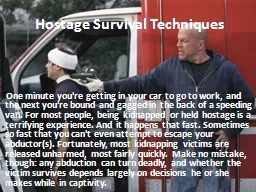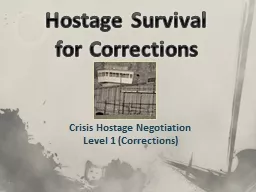PPT-Hostage Survival Techniques
Author : pamella-moone | Published Date : 2017-03-27
One minute youre getting in your car to go to work and the next youre bound and gagged in the back of a speeding van For most people being kidnapped or held
Presentation Embed Code
Download Presentation
Download Presentation The PPT/PDF document "Hostage Survival Techniques" is the property of its rightful owner. Permission is granted to download and print the materials on this website for personal, non-commercial use only, and to display it on your personal computer provided you do not modify the materials and that you retain all copyright notices contained in the materials. By downloading content from our website, you accept the terms of this agreement.
Hostage Survival Techniques: Transcript
Download Rules Of Document
"Hostage Survival Techniques"The content belongs to its owner. You may download and print it for personal use, without modification, and keep all copyright notices. By downloading, you agree to these terms.
Related Documents














